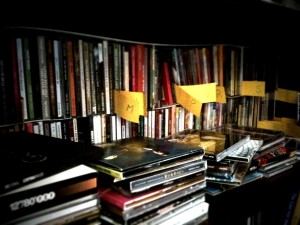The Day The CD Died
This photo is a snapshot of the pre-holiday chaos that reigned in just one of my CD storage spaces. I have CDs in two places in my apartment, some in short term storage and quite a few in long term storage. It’s a crazy, messy and yes, chaotic way to live. I’m quite fond of […]
This photo is a snapshot of the pre-holiday chaos that reigned in just one of my CD storage spaces. I have CDs in two places in my apartment, some in short term storage and quite a few in long term storage. It’s a crazy, messy and yes, chaotic way to live.
I’m quite fond of the word chaos. It implies disorder, randomness and confusion. However, in mythology, chaos is often the first step in the creative process. Great things happen when chaos is shaped into a form and becomes reality.
For me, having a substantial music library is important, personally and professionally. I love listening to music, finding new music, comparing different versions of the same tunes and developing playlists for any and every occasion (from CDs for holiday driving to mixes for everyday commuting). Moreover, I believe that listening carefully and attentively to a wide range of artists, as well as digging deep into your main genres is as important to a musician’s development as time spent in galleries for an artist or books read for a writer. Having a good music library is like digging yourself a deep well of inspiration and ideas.
However, this unformed mess of discs and cases repels me. To make matters worse, living in Hong Kong I simply can’t afford the shelf space to have the collection organised properly. For a while now the answer has seemed obvious – digitise my music library into something like iTunes, throw away the cases and just keep the discs and booklets in archive folders (which can hold a few hundred discs per folder/case).
Currently I encode my CDs as MP3s at 320kbps, which is a comprise I decided on some time ago. However, the costs of storage have dropped dramatically in recent years. So, whilst encoding CDs in .WAV format was prohibitively expensive a few years ago, now a 1TB hardrive, which is enough to hold over 2000 CDs worth of material encoded in 44.1k 16bit WAV, is available for less than $100US!
I never loved the CD format. I grew up with Vinyl and Cassettes and it took me a long time to, reluctantly, switch to CD. Despite the hype (and obvious lack of noise) I thought those early CDs sounded like rubbish and comparing the CD versions of some of my favourite albums with their Vinyl equivalent was enough to douse any enthusiasm for the format. In the end, I was left with no choice – the music industry stopped releasing new Vinyl.
There’s a kind of nostalgia that held me back from a purely digital music library, not just for Vinyl, but for the old album artwork that I loved so much. In fact, it’s probably fair to say that my eye for colour, typography, graphic design and even photography was largely developed through all those hours spent pouring over album covers.
Programmes like iTunes are cool as is being able to make music selections from anywhere in your house using an iPad-like device. Moreover, being able to store a whole lifetime’s worth of music on a few hard drives (and eventually, on one device) appeals deeply to my aesthetics. But, something has been lost. Looking at that little album cover image on an iPod, or even a larger image on the screen of my Mac can’t even be compared to the feeling of holding a Vinyl album cover in your hands.
All of which is a reminder that, for me at least, music isn’t just a product, a sound that buy as scratches on plastic or bits on a disc. Rather, music is about the relationship we have with a place and sometimes with a time in our lives. That’s why playlists matter – we want to experience places and times in our days differently. That’s why music libraries and collections matter;, they are like a biography of our lives, our changing tastes and even our travels. And, that’s why the way we store our music sometimes raises more questions than it answers.






